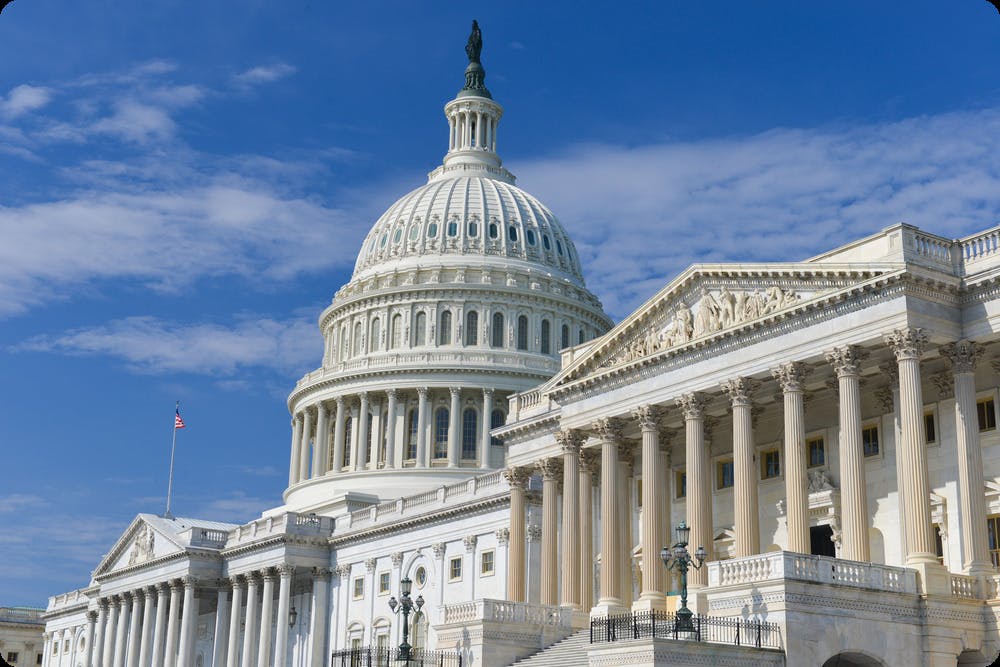The EB-5 Regional Center Program future hinges on the Integrity Act, which would extend the program for five years. IIUSA’s Leaders Advocacy Summit discussed the issue with industry stakeholders, as well as with Grassley and Leahy staff members. Some key takeaways: Congressional bandwidth is the biggest hurdle right now; the Act is likely going to be attached to another bill; pushing for program changes like derivative relief and extra visas now is a “recipe for inaction”; it’s vital that members of Congress hear from constituents who support EB-5.
Background to IIUSA’s engagement with the Hill
Capitol Hill engagement for IIUSA began in August and September of 2020. The offices of Senators Grassley (R-Iowa) and Leahy (D-Vermont) reached out to IIUSA exclusively to get the regional center association to help draft legislation that would address integrity measures and reauthorize the program for five years.
IIUSA worked with Senate staff trying to attach the legislation to the 2020 year-end omnibus spending bill. The EB-5 Integrity bill was not able to be attached to the omnibus bill (IIUSA Executive Director Aaron Grau didn’t offer up details as to why) and the Regional Center program was only reauthorized for six months, rather than the traditional 12-month extension the program had been seeing the past several years.
With a June 30th deadline looming, IIUSA and Grassley and Leahy’s Senate staffs then focused on creating a standalone bill to provide protections for investors, add “manageable” oversight for the industry, and provide the stability of a five-year reauthorization.
PART 1: RECAP OF THE CAPITOL HILL UPDATE ||abc|| IIUSA ADVOCACY STRATEGY SESSION
In the 2021 IIUSA Leaders Advocacy Summit, IIUSA’s first session was “Capitol Hill Update ||abc|| IIUSA Advocacy Strategy.”
The following is a summary of that session, and features comments from moderator and IIUSA Executive Director Aaron Grau, and panelists George McElwee (Managing Partner, Commonwealth Strategic Partners, a bipartisan lobbying firm based in Washington D.C.), Keith Pemrick (Managing Partner, Commonwealth Strategic Partners), and Charles Korrell (Vice President, Hillwood Investment Properties, a real estate development company).
Congressional bandwidth is the biggest hurdle right now
The biggest hurdle to the Integrity Act may simply be Congressional bandwidth, especially with the the recent proposal of Biden’s $2 Trillion-plus infrastructure plan. Keith Pemrick says that with the Integrity Act being introduced by two very senior and respected bi-partisan members, the bigger challenge is the Congressional calendar rather than the Act itself.
The Act is likely going to be attached to another bill
Charles Korrell, builds on this thought and tells us that the Integrity Act is not likely to see floor time as a stand-alone bill. Proponents of the Act will need to identify appropriate legislation to attach this bill to; this may happen in late April or early May.
Korrell says that the Act may be viewed as part of an economic recovery plan that thus may be attached to an infrastructure bill. Another viable option may be that the Act is part of a COVID-19 relief package as it’s a “logical” solution for businesses that have struggled during the pandemic.
Champions of the bill are needed — on the Hill and off of it
Korrell further advises that to get the focus of Congress, the Act will need the attention of members other than Grassley and Leahy — those members whose districts value the importance of EB-5. He says that to get leadership on both sides of the aisle to support the Act, junior members will need to raise their voices.
McElwee agrees and says that identifying potential champions of the bill is critical. A pro-active campaign with members of both the Senate and the House is required, to enlist co-sponsors for the Act; such a grass-roots movement of support will show House Speaker Nancy Pelosi and Schumer that action on EB-5 is needed.
Schumer’s office told McElwee “we need to hear from other people, and other groups who are in support of this.”
To that end, getting supporters outside of the political arena is vital; Korrel says organizations such as hotel associations need to reach out to Senate Majority Leader Chuck Schumer and let it be known that they are in support of EB-5 reauthorization — and that it needs to be done before June 30th.
Grau adds that the value of endorsements will be key, especially from the hospitality sector, which has been hardest hit by COVID-19 and which will be one of the biggest beneficiaries of EB-5.
When these forces — supporters on the Hill and off of it — coalesce, then, says McElwee, this will “alert Congress to find the bandwidth” to look at the Integrity Act.
Is anyone against the Integrity Act?
There are groups out there, small in number, McElwee tells us, that have been hoping to see a much broader bill introduced with other program changes. These people are not against the bill, per se; they simply want to see legislation that addresses EB-5 issues beyond integrity measures and long-term reauthorization.
However, he reminds us that Leahy and Grassley see integrity issues as the starting point. Only then can we move on to other changes. To think that the program might be expanded or substantively changed in other ways at the moment, “that’s just not on the table,” states McElwee.
When asked if any members of Congress are opposed to the bill, McElwee answered decisively: “No, none.” From his vantage point, other members of Congress who are considering EB-5 all bring up the issue of integrity and that’s something they want addressed in any legislation right now.
Pemrick has a more nuanced answer to the question of opposition and says that a big factor in the success of the bill is the legislation the Act gets attached to, as this will help position how the Act is viewed by various members of Congress.
He notes that while many want the Act to be seen as fitting in with an infrastructure package, there are “folks on Capitol Hill who see it strictly as immigration legislation.” And there are some on the far right who are opposed to immigration. Pemrick admits this needs to be navigated but he is optimistic and tells us that the Act has consensus on a bi-partisan basis.
Why not include derivative relief and increased visas in current EB-5 legislation?
Korrell supports the point that the the only way we can get long-term authorization is addressing integrity issues first. “No one’s going to want to expand the program unless we have integrity measures in place. This is a narrow bill designed to do just that.” He goes on to say that any efforts to broaden the program before addressing integrity measures will fall on deaf ears.
But Korrell gives hope to the notion that other issues important to the EB-5 industry, like backlog relief and processing times, can be addressed at a later point, after the Integrity Act is implemented: “If you have a program that is respected by members and the administration then hopefully we can start to address other issues down the line.”
Grau acknowledges that EB-5 stakeholders are eager to address the issues of derivative relief and increased visas. But he counsels there will be time later to take on these issues.
What might come next?
Support from the Senate Judiciary Committee, Pemrick states, is “integral” to the success of the Act. Senator Dick Durbin is chairmen of that committee and his staff has already met with the offices of Leahy and Grassley.
The next step Pemrick foresees will likely be a hearing in the committee, followed by a “mark-up” of the bill to allow members of the committee to offer amendments, if they can agree with Leahy and Grassley on the number of amendments. After the mark-up, the Act will need to find a vehicle to be attached to.
The Act will also require introduction in the House; that will be important, and will entail at the very least a markup, but also maybe a hearing; and the new Secretary of Homeland Security, Alejandro Mayorkas, will be consulted.
If the Act is attached to another infrastructure bill, it won’t go through the Senate Judiciary Committee; it will go through Transportation Committee in the House, and the Finance Committee in the Senate. If that is the path forward, proponents of the Act would have to work with those members; fortunately Grassley is chair of the Finance Committee, if that is the route forward.
However, at least initially, Pemrick anticipates the Act will go through the Senate Judiciary committee. He doesn’t see a “hotline” to get the bill on the Senate floor, where any one Senator can object to the bill.
Regarding next steps, McElwee reiterates that while they don’t see members who are opposed to the bill, they need members to directly support the bill and make a “statement” as co-sponsors.
What does Congress know about EB-5 and the bill right now
Grau asked the panel, what percent of members of Congress see EB-5 as too big to fail? What’s the thinking of rank-and-file members of EB-5 and the bill?
Korrell tells us that traditionally EB-5 has only been important to a very small group of members in the Senate and the House (particularly the former), and that in past reauthorizations no one gave the program significant attention.
But now the EB-5 Regional Center Program is “front and center” for more members because of the expiry date. Korrell points out that the staff of the Senator from California is “keenly aware of EB-5,” and he’s the chair of the immigration sub-committee in the Senate Judiciary — but other members still need to be educated about EB-5.
Pemrick breaks down the numbers and tells us that there are 39 states that have EB-5 investments in the recent past, 202 Congressional Districts with EB-5 job creation. Of 202 districts maybe three dozen sit on the Judiciary Committee — they need to know about the program and the impact it has had in the past and will have in the future. He admits that there are plenty of members who don’t know the program is in jeopardy but that it is all of our jobs to educate them.
Impact of lawsuits on the bill and EB-5 advocacy
Two recent lawsuits have been filed challenging the EB-5 Modernization Regulations, one in District of Columbia, the other in the Northern District of California. Grau asked the panel, do these lawsuits impact the legislation?
Korrell states that regardless of outcomes of the cases or judge’s opinions doesn’t matter or change the lobbying and advocacy. The fact that Mayorkas has just ratified the Final Rule should shut down any further speculation that the lawsuits will impact the path of the Integrity Act.
Support the Coalition to Save and Create Jobs
McElwee implores EB-5 stakeholders to join the Coalition to Save and Create Jobs— and encourage their chamber of commerce, their mayor, their governor and others to do the same. This enables advocates of the Integrity Act to to approach members of Congress, and with evidence of the support from their constituencies.
Think of membership in the coalition as “co-sponsorship,” McElwee offers. Recently the national hotel association and the National Association of Realtors have joined the coalition, so momentum is growing.
Can the June 30th expiry date be extended — possibly to September 30th?
What are the chances of an expiry date extension? Is it possible that the June 30th deadline could be moved by three months to September 30th, thus returning the EB-5 Regional Center Program to a future omnibus bill?
Pemrick doesn’t deny there is a possibility of an extension as these things often happen with Congress. But that doesn’t change the mandate for supporters of the Act to diligently work with the June 30th deadline as a goal. And the staffs of Senators Leahy and Grassley are also working hard under the assumption that program expiry date will not change.
After Congress took the program off of the appropriations cycle, McElwee sees it as “very unlikely” that it would be put back on.
Another point to consider is that given the momentum of the Integrity Act advocacy, if an extension is still needed, that extension could be a day, a week or any amount of time — not necessarily three months to Sept 30.
Korrell is blunt and says he doesn’t believe Grassley and Leahy will just “roll over” and allow for a program extension without getting the integrity measures implemented. Momentum has been built — let’s do the work and capitalize on it.
PART 2: RECAP OF THE CONGRESSIONAL STAFF ROUNDTABLE
In the third session of the IIUSA EB-5 Leaders Advocacy summit Executive Director Aaron Grau spoke with Congressional staff who work directly on the Integrity Act legislation: Drew Robinson, Senate Judiciary Committee Staff, Counsel, working directly with Senator Grassley; and Rajiv Venkataramanan Senate Judiciary Staff, Chief Counsel, working with Senator Leahy.
Grau starts the session by addressing the myth that Grassley is against the program. Both Grassley and Leahy, he maintains, “are dedicated to its continuance with vigor.”
Why is EB-5 important to Senator Grassley?
Grassley, Drew Robinson reminds us, was there when EB-5 started in the early 90s, and knows of what the program can offer.
Coming from Iowa, the rural aspect is of particular interest to Grassley. “He definitely understands the program can provide a lot of value in rural and truly distressed areas.” However, the Senator believes the program has deviated from the original goal of Congress.
Beyond the rural aspect, from around 2011 Grassley has had concerns about EB-5 regarding fraud and national security and wanted to address these issues.
Grassley is aware of the discussions about investment levels and Targeted Employment Areas (TEAs), etc., but for him, integrity reform is the first element that must be addressed before anything else.
Leahy’s dedication to EB-5 and his ‘bi-partisan bromance’ with Grassley
Senator Leahy is from Vermont and like Grassley “absolutely cares about rural investments,” Rajiv Venkataramanan declares. But with a broader perspective, the two senators have long worked together on cleaning up and exposing fraud and waste in the government; “EB-5 is a really good continuation of that bi-partisan bromance.”
The two Senators have a long history of working together to make sure government programs are accountable and work the way they’re supposed to; despite some other political differences, they are united in this aim.
Criticism of the Act — and addressing other EB-5 issues at a later date
The bill, Grau acknowledges, has some opposition from those who hold the view that it’s a mistake if the legislation doesn’t reform investment amounts, cost differential, Targeted Employment Area requirements, etc.
Robinson agrees that the criticism is not about what’s in the bill, but what’s not in it. But he says that in spite of outstanding issues you have to move forward on things you agree on when given the opportunity.
Those other issues would “blow up the agreement” right now; Robinson says that lessons from the past have shown us that we can’t let other issues get in the way of what we now agree on: the longterm stability the industry wants, and the reforms Senators Grassley and Leahy believe are necessary.
The Grassley staffer advises that just because we’re moving forward with the Integrity Act doesn’t mean you can’t revisit other areas of the program in the future.
Venkataramanan agrees and puts forward the old political adage that legislation is a game of inches. He cautions against the idea that all EB-5 program changes need to put into a current reauthorization package: to push for that is a “recipe for total inaction.”
Instead, we should acknowledge that while the Integrity Act doesn’t address every program issue, it still “does a whole lot of good and ensures the continuity and survival of the program.”
What are the most important provisions of the Integrity Act?
Representing EB-5 stakeholders, Grau is quick to point out what he sees as the paramount benefit: five years of program stability.
As a member of Grassley’s staff, Robinson’s response is, not surprisingly, a little different; he points to all of section 2 (broader Regional Center integrity reforms and reporting requirements) as being of vital significance, but specifically he references subparagraph N “Threats to National Interest”, and subparagraph O “Fraud, Misrepresentation, and Criminal Misuse” as being especially critical.
The Chief Counsel for Senator Leahy, Venkataramanan has a similar point of view. He declares that all of the fraud and misrepresentations, national security provisions are critical to Leahy, and are the “beating heart of the integrity reforms of the bill.”
Additionally, he states that the integrity fund is also very important to Leahy: “Everyone who cares about the program should have some skin in the game” and that’s why everyone should contribute to the fund.
“The long-term survival of this program depends on that collective desire to continually reform the program,” declares the Leahy staffer. And the Integrity fund allows stakeholders to be directly responsible to help ensure the success of that mandate.
The Act also contains important benefits for Investors, Grau notes: “Too often the investors are overlooked because they’re not here, or they may be in the backlog, but the truth of the matter is the investor community is the lifeblood [of EB-5].”
What does the legislative process look like between now and June 30th?
It’s important for us not to speculate too much, Venkataramanan advises. ”There will be a number of bills in the Senate being considered in the next few months,” thus making it difficult to say right now what exactly the legislative route will be.
But as there are 100 Senators, much education and lobbying will be going on. Robinson tells us, “my counterparts in the House Judiciary Committee and in the House Republican leadership are aware of our efforts.” But more outreach is still needed to make sure everyone is aware of the Act and its importance.
Regarding what other legislation the Integrity Act might be attached to, it’s also very early to speculate. Robinson says there are a lot of moving parts right now, and there has been discussion of potential vehicles this could ride on. No matter what the course may be, leadership at both the committee and chamber level will be involved.
Framing EB-5 as economic development, not immigration, is vital
It’s critical that the Act and EB-5 be “framed” in the right way to members of Congress. Economic development should be the lead story, not immigration.
Grau states, “I have come to view EB-5 as an economic development program that happens to be painted with an immigration brush.” He wants those less familiar with the program to understand his perspective that EB-5 is an “unsung juggernaut in economic development.”
Grassley’s focus on EB-5 centres on the Congressional intent of the program to support infrastructural projects, supporting economy and local communities by channeling investment in areas that might not otherwise get it. And for him, the Act is an opportunity to get things back on track.
Robinson tells us that infrastructure is the focus of the Senate right now so we need to highlight EB-5’s relevance in this context for members. There is “pretty broad agreement that using EB-5 for those sort of projects is incredibly helpful,” he says.
From Venkataramanan’s perspective, he echoes the need to position EB-5 in the right light. He admits that it is a “niche” program so it’s important to tie it into the broader and relevant themes of job creation and infrastructure.
He also warns that there are unhelpful ways to talk about the EB-5 program — such as including it in a discussion about immigration reform — that would be “opening up pandora’s box on all things immigration.”
What the EB-5 community needs to do: support the bill and tell members of Congress what EB-5 means to you
One of the frustrations for Senators Grassley and Leahy in the past has been members of the stakeholder community not interested in supporting their EB-5 reform, Robinson admits. And it’s important that this be counteracted this time around.
Venkataramanan tells the EB-5 community that there are going to be tough conversations on the Democratic side. So it’s absolutely essential for those members of Congress who will be “tough conversations” to hear from stakeholders in their districts, from their states about the broad support for this bill.
“Nothing resonates with members like hearing from constituents, business in their districts, big entities in their states, nothing resonates like that. Can’t emphasize that enough,” advises Venkataramanan. Also, it’s helpful for the EB-5 community to report on the substance and “flavor” of conversations to the Grassley and Leahy offices as the EB-5 industry often discovers things first. When we share “intel” they might not have yet, it helps inform their strategy.
Venkataramanan also gives us this bit of insight: Members of Congress often run with the last piece of information they receive, so they need current conversations in May and June. There you have it, EB-5 stakeholders: Let your members of Congress know exactly who supports the Integrity Act and EB-5 and why. The education campaign needs to begin in earnest now and can’t let up until this economy-rebuilding program has the long-term reauthorization it deserves — and the nation needs.








